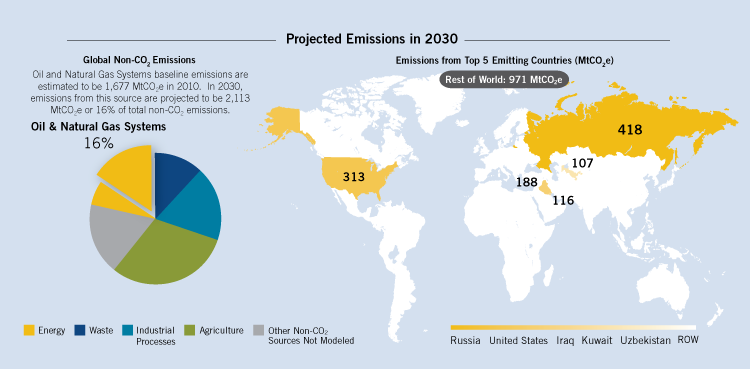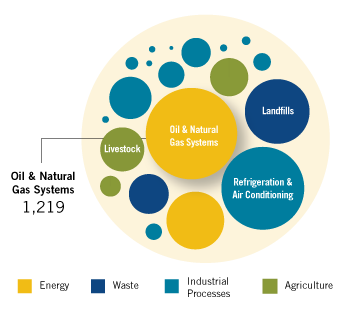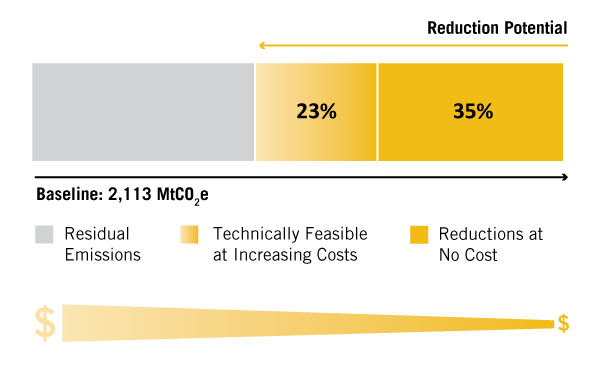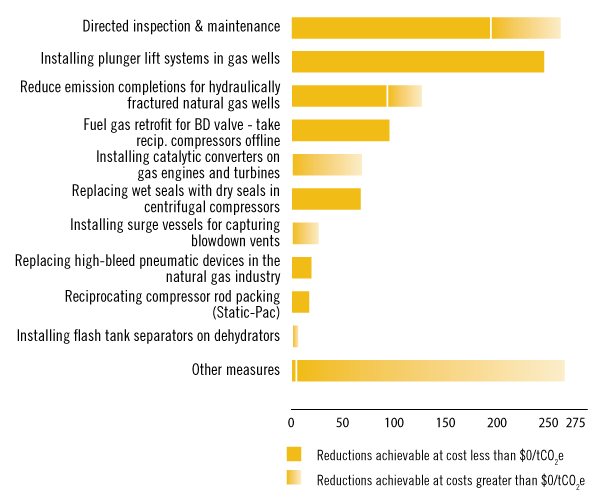Global Mitigation of Non-CO2 Greenhouse Gases: Oil and Natural Gas Systems
Key Points
- The technological maximum for emissions reduction potential in oil and gas is 1,219 million metric tons of carbon dioxide equivalent (MtCO2e), approximately 58% of projected emissions in 2030.
- Because of the energy value of the methane captured, EPA estimates that 747 MtCO2e, or 40% of the baseline emissions, can be cost-effectively reduced.
- Over 26% of total abatement potential is achieved by adopting abatement measures in the oil and gas production segments.
Sector Description
Oil and natural gas systems are one of the leading emitters of anthropogenic CH4, releasing 1,677 MtCO2e, or 23% of total global CH4 emissions in 2010. The top five CH4 emitters from oil and natural gas systems in 2010 were Russia, the United States, Iraq, Kuwait, and Uzbekistan. Global emissions from the oil and natural gas system are projected to grow 26% between 2010 and 2030, with Brazil and Iraq experiencing the highest growth rates at 128% and 100%, respectively.
 View or download the full-size image here. (129 K, PNG)
View or download the full-size image here. (129 K, PNG)
Emissions Reduction Potential
Assuming full implementation of current technology, emissions in the oil and natural gas systems sector could be reduced by up to 1,219 MtCO2e in 2030. This accounts for 26% of the 4,615 MtCO2e in global reduction potential in 2030.  View or download the full-size image here.(114 K, PNG)
View or download the full-size image here.(114 K, PNG)
Abatement Potential
In 2010, the global abatement potential in the oil and natural gas sector is projected to be 997 MtCO2e, or 60% of total emissions. The abatement potential increases over time growing to 1,103 and 1,218 MtCO2e in 2020 and 2030, respectively. Nearly 70% of the emissions reductions in 2030 are achievable at break-even prices at or below $5.  It would be cost-effective to reduce emissions by 35%, compared to the baseline, in 2030. An additional 23% reduction is available using technologies with increasingly higher costs.
It would be cost-effective to reduce emissions by 35%, compared to the baseline, in 2030. An additional 23% reduction is available using technologies with increasingly higher costs.
View or download the full-size image here.(37 K, PNG)
Abatement Measures
Numerous abatement measures are available to mitigate CH4 emissions across the four oil and natural gas system segments of production, processing, transmission, and distribution. The measures may be applied to various components or equipment commonly used in oil and natural gas system segments. The abatement measures typically fall into three categories: equipment modifications/upgrades; changes in operational practices, including direct inspection and maintenance; and installation of new equipment.  Emissions reductions by technology in 2030 at $0/tCO2e and at higher prices.
Emissions reductions by technology in 2030 at $0/tCO2e and at higher prices.
View or download the full-size image here.(58 K, PNG)
